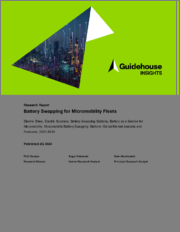
|
시장보고서
상품코드
1476284
세계의 마이크로모빌리티 플릿용 배터리 교체 시장 - 전기 자전거, 전기 스쿠터, 배터리 교체 스테이션, 마이크로모빌리티용 Baas(Battery as a Service), 마이크로모빌리티용 배터리 교체 스테이션 : 시장 분석 및 예측(2024-2033년)Battery Swapping for Micromobility Fleets - Electric Bikes, Electric Scooters, Battery Swapping Stations, Battery as a Service for Micromobility, Micromobility Battery Swapping Stations: Global Market Analysis and Forecasts, 2024-2033 |
||||||
배터리 교체는 전기 마이크로모빌리티의 지속적인 성장을 촉진할 수 있는 잠재력을 지닌 신기술로, 상당한 이익을 가져다 줄 수 있는 새로운 기술입니다. 지속가능하고 저렴하며 효율적인 도시 교통수단이라는 장점을 가진 마이크로모빌리티 차량은 지난 10년간 전 세계적으로 빠르게 성장하고 있습니다. 차량 배터리는 편리한 위치에 위치한 배터리 교체 스테이션(BSS)에서 몇 분 안에 교체할 수 있습니다. 이를 통해 기존 충전 허브에서 충전하는 데 드는 물류 노력과 운영 비용을 크게 줄이고 차량 가동 중단 시간을 줄여 수익을 극대화할 수 있습니다. 또한, 배터리 교체는 충전에 필요한 물류 노동력을 줄이고, 에너지 저장 시스템으로 사용되어 재생에너지 원과 통합될 경우 전력망의 이익으로 인해 지속가능성의 이점을 가져다 줄 수 있습니다.
마이크로모빌리티 배터리 교체는 차량 운영 비용 절감, 사용자 충전 경험 개선, 환경적 이점을 약속합니다. 배터리 교체는 여러 가지 도전 과제에 직면해 있지만, 배터리 교체 프로그램에 사용되는 차량용 마이크로모빌리티 차량, 배터리 교체 스테이션 설치 수, BaaS(Battery as a Service) 비즈니스 모델을 통한 수익은 꾸준히 증가할 것으로 예상됩니다. 수익은 견조한 성장세를 보일 것으로 예상됩니다. 기술 발전과 비용 효율화로 인해 마이크로모빌리티 차량용 BaaS의 수익 성장과 보급이 가속화될 것으로 예상됩니다.
이 보고서는 세계 마이크로모빌리티 플릿용 배터리 교체 시장에 대해 조사 분석했으며, 시장 촉진요인과 장벽, 차량 판매량 및 가동률 예측 등의 정보를 제공합니다.
목차
제1장 주요 요약
- 소개
- 시장 하이라이트
제2장 시장 문제
- 성장 촉진요인
- 운영 효율
- 전기 마이크로모빌리티 플릿 확대
- 지속가능성
- 장벽
- 배터리 표준화
- 인프라 비용
- 안전성과 합법성
제3장 산업 밸류체인
- 마이크로모빌리티용 배터리 교체 밸류체인
- 배터리 제조업체
- 자동차 OEM
- 배터리 교체 프로바이더
- 마이크로모빌리티 플릿 사업자
- 최종사용자
- 재활용, 재사용
- 경쟁 상황
- 배터리 교체 프로바이더
- 마이크로모빌리티 사업자
- 차량 OEM
- 비즈니스 모델의 진화
- Pay-per-Swap
- BaaS
제4장 시장 예측
- 범위와 조사 방법
- 플릿 마이크로모빌리티 차량 판매대수
- 플릿 마이크로모빌리티 차량 가동대수
- BaaS용 마이크로모빌리티 차량 전개
- BaaS용 배터리와 BSS
제5장 결론과 추천
- 3개 주요 사항
- 추천
- 배터리 제조업체
- 배터리 교체 프로바이더
- 마이크로모빌리티 플릿 사업자
제6장 두문자어와 약어 리스트
제7장 목차
제8장 도표
제9장 조사 범위
제10장 정보 출처, 조사 방법, 주석
ksm 24.05.17Battery swapping is an emerging technology with potential to provide important benefits and stimulate the continued growth of electric micromobility. With their advantages of sustainable, low cost and efficient urban transportation, micromobility fleets have experienced rapid global growth over the past decade. Vehicle batteries can be exchanged in a matter of minutes at a conveniently located battery swapping station (BSS). This drastically reduces the logistical efforts and operational costs for charging at a conventional charging hub, and reduces vehicle downtime, thus maximizing revenue generation. Further, battery swapping brings sustainability advantages as a result of fewer logistical efforts required for charging, and from grid benefits when they are used as energy storage systems and integrated with renewable energy sources.
Battery swapping for micromobility promises to reduce fleet operating costs, providing an improved charging experience for its users and delivering environmental benefits. Though battery swapping faces multiple challenges, Guidehouse Insights forecasts solid growth in fleet micromobility vehicles used in battery swapping programs, the installations of battery swapping stations, and revenue generated through the battery as a service business model. Technology advances and cost efficiencies will drive revenue growth and increase penetration of battery as a service (BaaS) for micromobility fleets.
This Guidehouse Insights research report examines the global market for battery swapping for micromobility fleets. Forecasts include unit sales of fleet micromobility vehicles (e-bikes, e-kick scooters and seated e-scooters), installed bases of fleet micromobility vehicles, deployments of fleet micromobility vehicles for BaaS, and deployments of batteries and BSS for BaaS, for the 10-year forecast period of 2024-2033.
Table of Contents
1. Executive Summary
- 1.1 Introduction
- 1.2 Market Highlights
2. Market Issues
- 2.1 Drivers
- 2.1.1 Operational Efficiencies
- 2.1.1.1 BSS Advantages
- 2.1.1.2 Improved Fire Risk Management
- 2.1.2 Growth of Electric Micromobility Fleets
- 2.1.3 Sustainability
- 2.1.1 Operational Efficiencies
- 2.2 Barriers
- 2.2.1 Battery Standardization
- 2.2.2 Infrastructure Costs
- 2.2.3 Safety and Legality
3. Industry Value Chain
- 3.1 Battery Swapping for Micromobility Value Chain
- 3.1.1 Battery Manufacturers
- 3.1.2 Vehicle OEMs
- 3.1.3 Battery Swapping Providers
- 3.1.4 Micromobility Fleet Operators
- 3.1.5 End Users
- 3.1.6 Recycling and Re-Use
- 3.2 Competitive Landscape
- 3.2.1 Battery Swapping Providers
- 3.2.2 Micromobility Operators3.2.3 Vehicle OEMs
- 3.3 Business Model Evolution
- 3.3.1 Pay-per-Swap
- 3.3.2 BaaS
4. Market Forecasts
- 4.1 Scope and Methodology
- 4.2 Fleet Micromobility Vehicle Unit Sales
- 4.3 Installed Base of Fleet Micromobility Vehicles
- 4.4 Micromobility Vehicle Deployments for BaaS
- 4.5 Batteries and BSSs for BaaS
5. Conclusions and Recommendations
- 5.1 Three Big Takeaways
- 5.2 Recommendations
- 5.2.1 Battery Manufacturers
- 5.2.1.1 Ensure Batteries Are Optimized for Swapping for Micromobility Applications
- 5.2.1.2 Collaborate with Stakeholders to Meet Customer Requirements
- 5.2.1.3 Work Toward Standardization
- 5.2.1.4 Develop BMS
- 5.2.1.5 Develop Batteries with Second-Life Strategies in Mind
- 5.2.2 Battery Swapping Providers
- 5.2.2.1 Provide Competitive Pricing Models
- 5.2.2.2 Provide a Reliable Battery Swapping Service
- 5.2.2.3 Optimize the User Experience
- 5.2.2.4 Provide Options for Renewable Energy Integration
- 5.2.3 Micromobility Fleet Operators
- 5.2.3.1 Engage with Battery Swapping Providers
- 5.2.3.2 Assess Fleet Needs
- 5.2.3.3 Trial Battery Swapping Operations
- 5.2.1 Battery Manufacturers



















